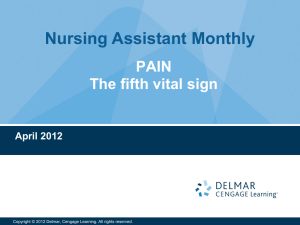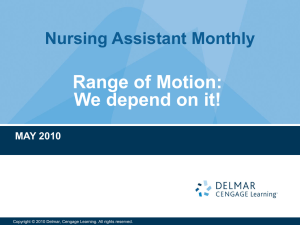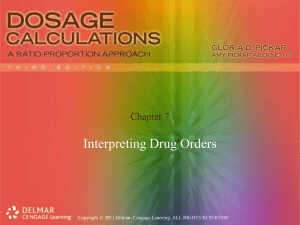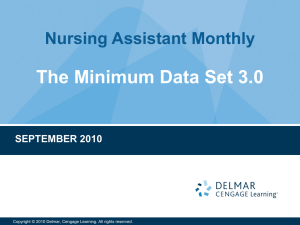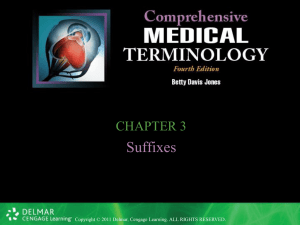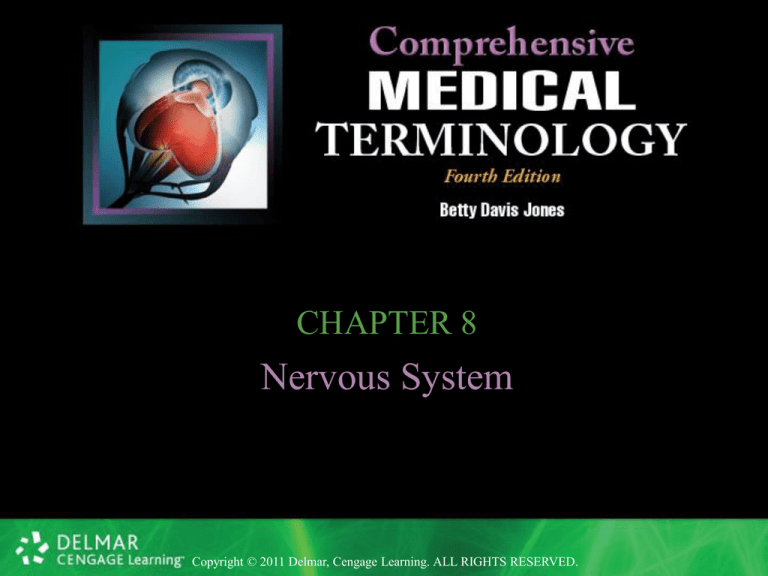
CHAPTER 8
Nervous System
Copyright © 2011 Delmar, Cengage Learning. ALL RIGHTS RESERVED.
Nervous System Overview
• Nervous system consists of:
– Brain
– Spinal cord
– Nerves
• Functions of nervous system
– Regulates and coordinates all body activities
– Center of all mental activity, including thought, learning,
and memory
Copyright © 2011 Delmar, Cengage Learning. ALL RIGHTS RESERVED.
Nervous System Divisions
• Central nervous system (CNS)
–
–
–
–
Brain
Spinal cord
Processes and stores sensory and motor information
Controls consciousness
Copyright © 2011 Delmar, Cengage Learning. ALL RIGHTS RESERVED.
Nervous System Divisions
• Peripheral nervous system (PNS)
– 12 pairs of cranial nerves
– 31 pairs of spinal nerves
– Transmits sensory and motor impulses back and forth
between CNS and rest of body
Copyright © 2011 Delmar, Cengage Learning. ALL RIGHTS RESERVED.
Nervous System Divisions
Copyright © 2011 Delmar, Cengage Learning. ALL RIGHTS RESERVED.
Question
True or False: Basically, the central nervous
system (CNS) is the command center, and
the peripheral nervous system (PNS) is the
messenger.
Copyright © 2011 Delmar, Cengage Learning. ALL RIGHTS RESERVED.
Peripheral Nervous System
• Afferent (sensory) nerves
– Carry impulses from the body to the central nervous
system
• Efferent (motor) nerves
– Carry impulses from the central nervous system to
muscles and glands
– Cause the target organs to do something in response to
commands
Copyright © 2011 Delmar, Cengage Learning. ALL RIGHTS RESERVED.
Peripheral Nervous System
• Somatic nervous system (SNS)
– Provides voluntary control over skeletal muscle
contractions
• Autonomic nervous system (ANS)
– Provides involuntary control over smooth muscle,
cardiac muscle, and glandular activity and secretions in
response to the commands of the central nervous system
Copyright © 2011 Delmar, Cengage Learning. ALL RIGHTS RESERVED.
Autonomic Nervous System
• Sympathetic nerves
–
–
–
–
Increase heart rate
Constrict blood vessels
Raise blood pressure
Fight-or-flight response
Copyright © 2011 Delmar, Cengage Learning. ALL RIGHTS RESERVED.
Autonomic Nervous System
• Parasympathetic nerves
–
–
–
–
Slow heart rate
Increase peristalsis of intestines
Increase glandular secretions
Relax sphincters
Copyright © 2011 Delmar, Cengage Learning. ALL RIGHTS RESERVED.
Question
__________ nerves carry the impulses from
the body to the CNS, while __________
nerves carry the impulses from the CNS to
the body.
a.
b.
c.
d.
Somatic, autonomic
Afferent, efferent
Autonomic, somatic
Efferent, afferent
Copyright © 2011 Delmar, Cengage Learning. ALL RIGHTS RESERVED.
Cells of the Nervous System
• Neuron
– Cell body
• Contains the nucleus and cytoplasm
– Axon
• Conducts impulses away from the cell body
• Some axons are covered with a myelin sheath
Copyright © 2011 Delmar, Cengage Learning. ALL RIGHTS RESERVED.
Cells of the Nervous System
• Neuron
– Dendrite
• Conducts impulses toward the cell body
– Synapse
• Space between two nerves which the impulse must cross
Copyright © 2011 Delmar, Cengage Learning. ALL RIGHTS RESERVED.
Cells of the Nervous System
Copyright © 2011 Delmar, Cengage Learning. ALL RIGHTS RESERVED.
Cells of the Nervous System
• Neuroglia
– Connective tissue
• Support system for neurons
– Do not conduct impulses
– Protect nervous system through phagocytosis
Copyright © 2011 Delmar, Cengage Learning. ALL RIGHTS RESERVED.
Cells of the Nervous System
• Types of neuroglia cells
– Astrocytes
– Microglia
– Oligodendrocytes
Copyright © 2011 Delmar, Cengage Learning. ALL RIGHTS RESERVED.
Central Nervous System
• Brain
– Surrounded by bone for protection
– Enclosed in cranium
• Spinal cord
– Surrounded by vertebrae for protection
– Surrounded by meninges and cerebrospinal fluid
Copyright © 2011 Delmar, Cengage Learning. ALL RIGHTS RESERVED.
Meninges
• Dura mater
– Outermost layer of meninges
– Tough, white connective tissue
– Epidural space
• Located outside of the dura mater
• Contains supporting cushion of fat and connective tissue
Copyright © 2011 Delmar, Cengage Learning. ALL RIGHTS RESERVED.
Meninges
• Dura mater
– Subdural space
• Located beneath the dura mater
• Cavity is filled with serous fluid
Copyright © 2011 Delmar, Cengage Learning. ALL RIGHTS RESERVED.
Meninges
• Arachnoid membrane
– Middle layer of the meninges
– Resembles a spider web
– Subarachnoid space immediately beneath
• Contains cerebrospinal fluid
• Pia mater
– Innermost layer of the meninges
– Tightly bound to the surface of the brain and spinal cord
Copyright © 2011 Delmar, Cengage Learning. ALL RIGHTS RESERVED.
Structures of the Brain
• Cerebrum
– Largest and uppermost portion of the brain
– Controls consciousness, memory, sensations, emotions,
voluntary movements
– Cortex = outer surface
Copyright © 2011 Delmar, Cengage Learning. ALL RIGHTS RESERVED.
Structures of the Brain
• Cerebrum
– Gyri = elevations
– Sulci = grooves
– Longitudinal fissure divides cerebrum into two
hemispheres
Copyright © 2011 Delmar, Cengage Learning. ALL RIGHTS RESERVED.
Structures of the Brain
• Cerebellum
– Attached to the brain stem
– Maintains muscle tone
– Coordinates normal movement and balance
• Diencephalon
– Located between cerebrum and midbrain
– Consists of thalamus, hypothalamus, and pineal gland
Copyright © 2011 Delmar, Cengage Learning. ALL RIGHTS RESERVED.
Structures of the Brain
• Brain stem
– Region between diencephalon and spinal cord
– Consists of midbrain, pons, and medulla oblongata
– Serves as pathway for impulses between brain and spinal
cord
– Controls respiration, blood pressure, and heart rate
Copyright © 2011 Delmar, Cengage Learning. ALL RIGHTS RESERVED.
Structures of the Brain
Copyright © 2011 Delmar, Cengage Learning. ALL RIGHTS RESERVED.
Structures of the Brain
Copyright © 2011 Delmar, Cengage Learning. ALL RIGHTS RESERVED.
Spinal Cord
• Pathway for impulses traveling to and from
brain
• Carries 31 pairs of spinal nerves
• Affects limbs and lower part of body
Copyright © 2011 Delmar, Cengage Learning. ALL RIGHTS RESERVED.
Question
Which part of the brain enables you to read this
question and answer it correctly?
a.
b.
c.
d.
cerebrum
cerebellum
brain stem
meninges
Copyright © 2011 Delmar, Cengage Learning. ALL RIGHTS RESERVED.
PATHOLOGICAL CONDITIONS
Nervous System
Copyright © 2011 Delmar, Cengage Learning. ALL RIGHTS RESERVED.
Alzheimer’s Disease
• Pronounced
– (ALTS-high-merz dih-ZEEZ)
• Defined
– Progressive and extremely debilitating deterioration of a
person’s intellectual functioning
Copyright © 2011 Delmar, Cengage Learning. ALL RIGHTS RESERVED.
Amyotrophic Lateral Sclerosis (ALS)
• Pronounced
– (ah-my-oh-TROFF-ik LAT-er-al skleh-ROH-sis)
• Defined
– Severe weakening and wasting of the involved muscle
groups
– Usually begins with hands
– Progresses to shoulders, upper arms, then legs
Copyright © 2011 Delmar, Cengage Learning. ALL RIGHTS RESERVED.
Anencephaly
• Pronounced
– (an-en-SEFF-ah-lee)
• Defined
– Absence of the brain and spinal cord at birth
– Condition is incompatible with life
Copyright © 2011 Delmar, Cengage Learning. ALL RIGHTS RESERVED.
Bell’s Palsy
• Pronounced
– (BELLZ PAWL-zee)
• Defined
– Temporary or permanent unilateral weakness or paralysis
of muscles in the face
Copyright © 2011 Delmar, Cengage Learning. ALL RIGHTS RESERVED.
Brain Abscess
• Pronounced
– (BRAIN AB-sess)
• Defined
– Accumulation of pus located anywhere in the brain tissue
Copyright © 2011 Delmar, Cengage Learning. ALL RIGHTS RESERVED.
Carpal Tunnel Syndrome
• Pronounced
– (CAR-pal TUN-el SIN-drohm)
• Defined
– Pinching or compression of median nerve within the
carpal tunnel
– Inflammation and swelling of tendons cause intermittent
or continuous pain
Copyright © 2011 Delmar, Cengage Learning. ALL RIGHTS RESERVED.
Question
True or False: The breakdown of the word
anencephaly is an = without or not,
encephal– = skull, and –y makes it a noun.
Copyright © 2011 Delmar, Cengage Learning. ALL RIGHTS RESERVED.
Cerebral Concussion
• Pronounced
– (seh-REE-bral con-KUSH-un)
• Defined
– Brief interruption of brain function, usually with loss of
consciousness lasting for a few seconds
Copyright © 2011 Delmar, Cengage Learning. ALL RIGHTS RESERVED.
Cerebral Contusion
• Pronounced
– (seh-REE-bral con-TOO-zhun)
• Defined
– Small, scattered venous hemorrhages in the brain
– Bruise of the brain tissue
– Occurs when brain strikes the inner skull
Copyright © 2011 Delmar, Cengage Learning. ALL RIGHTS RESERVED.
Cerebral Palsy
• Pronounced
– (seh-REE-bral PAWL-zee)
• Defined
– Collective term used to describe congenital brain damage
that is permanent but not progressive
– Characterized by the child’s lack of control of voluntary
muscles
Copyright © 2011 Delmar, Cengage Learning. ALL RIGHTS RESERVED.
Cerebral Palsy
• Spastic
– Damage to cortex of the brain
• Tense muscles
• Very irritable muscle tone
• Ataxic
– Damage to cerebellum
• Affects equilibrium
Copyright © 2011 Delmar, Cengage Learning. ALL RIGHTS RESERVED.
Cerebral Palsy
• Athetoid
– Damage to basal ganglia
• Causes sudden jerking
– Rigidity
• Causes child to be in continual state of tension
• Mixed cerebral palsy
– Combination of the 3 types
Copyright © 2011 Delmar, Cengage Learning. ALL RIGHTS RESERVED.
Question
Why is the disease called cerebral palsy instead
of cerebellar palsy?
a.
b.
c.
d.
It involves involuntary muscle.
It is all in the patient's head.
It doesn't sound as good.
It involves voluntary muscle.
Copyright © 2011 Delmar, Cengage Learning. ALL RIGHTS RESERVED.
Cerebrovascular Accident (CVA)
• Pronounced
– (seh-REE-broh-VASS-kyoo-lar AK-sih-dent)
• Defined
– Death of a specific portion of brain tissue
• Results from decreased blood flow to that area of the brain
– Also called a stroke
Copyright © 2011 Delmar, Cengage Learning. ALL RIGHTS RESERVED.
Cerebrovascular Accident
• Causes
– Transient ischemic attacks (TIAs)
• Also known as mini strokes
– Cerebral thrombosis
• Occurs largely in individuals older than 50
Copyright © 2011 Delmar, Cengage Learning. ALL RIGHTS RESERVED.
Cerebrovascular Accident
• Causes
– Cerebral embolism
• Embolus causes an occlusion
– Cerebral hemorrhage
• Cerebral vessel ruptures
Copyright © 2011 Delmar, Cengage Learning. ALL RIGHTS RESERVED.
Degenerative Disk
• Pronounced
– (deh-JEN-er-ah-tiv disk)
• Defined
– Deterioration of the intervertebral disk
– Usually due to constant motion and wear on the disk
Copyright © 2011 Delmar, Cengage Learning. ALL RIGHTS RESERVED.
Encephalitis
• Pronounced
– (en-seff-ah-LYE-tis)
• Defined
– Inflammation of the brain or spinal cord tissue
• Virus enters CNS when person experiences viral disease such as
mumps, measles, or through tick or mosquito bite
Copyright © 2011 Delmar, Cengage Learning. ALL RIGHTS RESERVED.
Epilepsy
• Pronounced
– (EP-ih-lep-see)
• Defined
– Syndrome of recurring episodes of excessive irregular
electrical activity of the central nervous system, called
seizures
Copyright © 2011 Delmar, Cengage Learning. ALL RIGHTS RESERVED.
Grand Mal Seizure
• Pronounced
– (grand MALL SEE-zyoor)
• Defined
– Epileptic seizure characterized by sudden loss of
consciousness and generalized involuntary muscular
contraction
– Vacillates between rigid body extension and an
alternating contracting and relaxing of muscles
Copyright © 2011 Delmar, Cengage Learning. ALL RIGHTS RESERVED.
Petit Mal Seizure
• Pronounced
– (pet-EE MALL SEE-zyoor)
• Defined
– Small seizures in which there is a sudden, temporary loss
of consciousness
– Lasts only a few seconds
– Also known as absence seizures
Copyright © 2011 Delmar, Cengage Learning. ALL RIGHTS RESERVED.
Guillain-Bàrré Syndrome
• Pronounced
– (GEE-yon bah-RAY SIN-drohm)
Copyright © 2011 Delmar, Cengage Learning. ALL RIGHTS RESERVED.
Guillain-Bàrré Syndrome
• Defined
– Acute polyneuritis of the peripheral nervous system
•
•
•
•
•
Myelin sheaths on the axons are destroyed
Decreased nerve impulses
Loss of reflex response
Sudden muscle weakness
Usually follows viral gastrointestinal or respiratory infection
Copyright © 2011 Delmar, Cengage Learning. ALL RIGHTS RESERVED.
Question
True or False: A cerebrovascular accident is a
misfiring of the electrical impulses in the
brain.
Copyright © 2011 Delmar, Cengage Learning. ALL RIGHTS RESERVED.
Headache (Cephalalgia)
• Pronounced
– (seff-ah-LAL-jee-ah)
• Defined
– Pain anywhere within the cranial cavity varying in
intensity from mild to severe
– May be chronic or acute
– May occur as result of a disease process
– May be totally benign
Copyright © 2011 Delmar, Cengage Learning. ALL RIGHTS RESERVED.
Migraine Headache
• Pronounced
– (MY-grain headache)
• Defined
– Recurring, pulsating, vascular headache developing on
one side of the head
– Characterized by slow onset
– May be preceded by an aura during which sensory
disturbance occurs
Copyright © 2011 Delmar, Cengage Learning. ALL RIGHTS RESERVED.
Cluster Headache
• Pronounced
– (KLUSS-ter headache)
• Defined
– Headache occurring typically two to three hours after
falling asleep
• Described as extreme pain around one eye that wakens the
person from sleep
Copyright © 2011 Delmar, Cengage Learning. ALL RIGHTS RESERVED.
Tension Headache
• Pronounced
– (TEN-shun headache)
• Defined
– Headache that occurs from long, endured contraction of
the skeletal muscles around the face, scalp, upper back,
and neck
Copyright © 2011 Delmar, Cengage Learning. ALL RIGHTS RESERVED.
Epidural Hematoma
• Pronounced
– (eh-pih-DOO-ral hee-mah-TOH-mah)
• Defined
– Collection of blood located above the dura mater and just
below the skull
Copyright © 2011 Delmar, Cengage Learning. ALL RIGHTS RESERVED.
Subdural Hematoma
• Pronounced
– (sub-DOO-ral hee-mah-TOH-mah)
• Defined
– Collection of blood below the dura mater and above the
arachnoid layer of the meninges
Copyright © 2011 Delmar, Cengage Learning. ALL RIGHTS RESERVED.
Herniated Disk
• Pronounced
– (HER-nee-ay-ted disk)
• Defined
– Rupture or herniation of the disk center through the disk
wall and into the spinal canal
• Causes pressure on the spinal cord or nerve roots
Copyright © 2011 Delmar, Cengage Learning. ALL RIGHTS RESERVED.
Huntington’s Chorea
• Pronounced
– (HUNT-ing-tonz koh-REE-ah)
• Defined
– Inherited neurological disease characterized by rapid,
jerky, involuntary movements and increased dementia
– Progressive, degenerative disease
Copyright © 2011 Delmar, Cengage Learning. ALL RIGHTS RESERVED.
Question
What type of headache would be most common
in a profession such as medical transcription,
which involves being in the same position for
an extended period of time?
a.
b.
c.
d.
cluster
migraine
tension
all of the above
Copyright © 2011 Delmar, Cengage Learning. ALL RIGHTS RESERVED.
Hydrocephalus
• Pronounced
– (high-droh-SEFF-ah-lus)
• Defined
– Abnormal increase of cerebrospinal fluid in the brain
that causes the ventricles of the brain to dilate
• Results in increased head circumference in infant with open
fontanel
• Congenital disorder
Copyright © 2011 Delmar, Cengage Learning. ALL RIGHTS RESERVED.
Intracranial Tumors
• Pronounced
– (in-trah-KRAY-nee-al TOO-morz)
• Defined
–
–
–
–
Tumors occurring in any structural region of the brain
May be malignant or benign
Classified as primary or secondary
Named according to the tissue from which they originate
Copyright © 2011 Delmar, Cengage Learning. ALL RIGHTS RESERVED.
Primary Intracranial Tumors
• Pronounced
– (PRIGH-mah-ree in-trah-KRAY-nee-al TOO-morz)
• Defined
– Tumors that arise from gliomas and the meninges
• Gliomas = malignant glial cells that are a support for nerve tissue
Copyright © 2011 Delmar, Cengage Learning. ALL RIGHTS RESERVED.
Primary Intracranial Tumors
• Glioblastoma multiforme
– Most rapidly growing of the gliomas
• Astrocytomas
– Tend to invade surrounding structures
• Ependymomas
– Occur more commonly in children and adolescents
– Usually encapsulated and benign
Copyright © 2011 Delmar, Cengage Learning. ALL RIGHTS RESERVED.
Metastatic Intracranial Tumors
(Secondary)
• Pronounced
– (met-ah-STAT-ik in-trah-KRAY-nee-al TOO-morz)
• Defined
– Tumors occurring as a result of metastasis from a
primary site such as the lung or breast
Copyright © 2011 Delmar, Cengage Learning. ALL RIGHTS RESERVED.
Meningitis (Acute Bacterial)
• Pronounced
– (men-in-JYE-tis) (ah-KYOOT back-TEE-ree-al)
• Defined
– Serious bacterial infection of the meninges
• Can have residual debilitating effects or even a fatal outcome
• Must be diagnosed and treated promptly with appropriate
antibiotic therapy
Copyright © 2011 Delmar, Cengage Learning. ALL RIGHTS RESERVED.
Question
True or False: A biopsy of a tumor in the brain
shows cells compatible with breast tissue.
This means it is a primary tumor.
Copyright © 2011 Delmar, Cengage Learning. ALL RIGHTS RESERVED.
Multiple Sclerosis (MS)
• Pronounced
– (MULL-tih-pl SKLEH-roh-sis)
• Defined
– Degenerative inflammatory disease of the central
nervous system attacking the myelin sheath in the spinal
cord and brain
• Leaves area sclerosed (hardened) or scarred
Copyright © 2011 Delmar, Cengage Learning. ALL RIGHTS RESERVED.
Myasthenia Gravis
• Pronounced
– (my-ass-THEE-nee-ah GRAV-is)
• Defined
– Chronic progressive neuromuscular disorder
– Causes skeletal muscle weakness (without atrophy) and
fatigue
• Occurring at different levels of severity
Copyright © 2011 Delmar, Cengage Learning. ALL RIGHTS RESERVED.
Narcolepsy
• Pronounced
– (NAR-koh-lep-see)
• Defined
– Rare syndrome of uncontrolled, sudden attacks of sleep
– Main features of narcolepsy are daytime sleepiness and
cataplexy
– Sudden loss of muscle tone
Copyright © 2011 Delmar, Cengage Learning. ALL RIGHTS RESERVED.
Neuroblastoma
• Pronounced
– (noo-roh-blass-TOH-mah)
• Defined
– Highly malignant tumor of the sympathetic nervous
system
– Most commonly occurs in the adrenal medulla with early
metastasis to liver, lungs, lymph nodes, and bone
Copyright © 2011 Delmar, Cengage Learning. ALL RIGHTS RESERVED.
Parkinson’s Disease
• Pronounced
– (PARK-in-sons dih-ZEEZ)
Copyright © 2011 Delmar, Cengage Learning. ALL RIGHTS RESERVED.
Parkinson’s Disease
• Defined
– Degenerative, slowly progressive deterioration of nerves
in the brain stem’s motor system, characterized by a
gradual onset of symptoms
• Classic symptoms: stooped posture with body flexed forward,
bowed head, shuffling gait, pill-rolling gestures, expressionless,
mask-like facial appearance
Copyright © 2011 Delmar, Cengage Learning. ALL RIGHTS RESERVED.
Peripheral Neuritis
• Pronounced
– (per-IF-er-al noo-RYE-tis)
• Defined
– Inflammation of one or more peripheral nerves
– Effects are dependent upon particular nerve involved
Copyright © 2011 Delmar, Cengage Learning. ALL RIGHTS RESERVED.
Poliomyelitis
• Pronounced
– (poh-lee-oh-my-ell-EYE-tis)
• Defined
– Infectious viral disease that affects the ability of spinal
cord and brain motor neurons to receive stimulation
• Virus enters through the upper respiratory tract
• Muscles affected become paralyzed without the motor nerve
stimulation
Copyright © 2011 Delmar, Cengage Learning. ALL RIGHTS RESERVED.
Post Polio Syndrome
• Pronounced
– (POST POH-lee-oh SIN-drohm)
• Defined
– Progressive weakness occurring at least 30 years after
the initial poliomyelitis attack
Copyright © 2011 Delmar, Cengage Learning. ALL RIGHTS RESERVED.
Reye’s Syndrome
• Pronounced
– (RISE SIN-drohm)
• Defined
– Acute brain encephalopathy along with fatty infiltration of
the internal organs that may follow acute viral infections
• Occurs in children under the age of 18; often with a fatal result
• Linked to aspirin administration during a viral illness
Copyright © 2011 Delmar, Cengage Learning. ALL RIGHTS RESERVED.
Shingles (Herpes Zoster)
• Pronounced
– (SHING-lz) (HER-peez ZOSS-ter)
• Defined
– Acute viral infection characterized by inflammation of
the underlying spinal or cranial nerve pathway producing
painful, vesicular eruptions on the skin along these nerve
pathways
• Seen mainly in adults
Copyright © 2011 Delmar, Cengage Learning. ALL RIGHTS RESERVED.
Shingles
Image courtesy of Robert A. Silverman,
M.D., Pediatric Dermatology,
Georgetown University
Copyright © 2011 Delmar, Cengage Learning. ALL RIGHTS RESERVED.
Skull Fracture (Depressed)
• Pronounced
– (SKULL FRAK-chur) (deh-PREST)
• Defined
– Broken segment of the skull bone thrust into the brain as
a result of a direct force, usually a blunt object
Copyright © 2011 Delmar, Cengage Learning. ALL RIGHTS RESERVED.
Spina Bifida Cystica
• Pronounced
– (SPY-nah BIFF-ih-dah SISS-tih-kah)
• Defined
– Back portion of one or more vertebrae is not closed
normally and a cyst protrudes through the opening in the
back, usually at the level of the 5th lumbar or 1st sacral
vertebrae
– Congenital defect of the CNS
Copyright © 2011 Delmar, Cengage Learning. ALL RIGHTS RESERVED.
Question
There have been 3 disorders mentioned so far
that only affect peripheral nerves. They are:
a. Parkinson's, poliomyelitis, and Bells' palsy
b. Myasthenia gravis, shingles, and carpal tunnel
syndrome
c. Bell's palsy, carpal tunnel syndrome, and peripheral
neuritis
d. Shingles, peripheral neuritis, and poliomyelitis
Copyright © 2011 Delmar, Cengage Learning. ALL RIGHTS RESERVED.
Meningocele
• Pronounced
– (men-IN-goh-seel)
• Defined
– Cyst-like sac covered with skin or a thin membrane
protruding through the bony defect in the vertebrae
containing meninges and CSF
Copyright © 2011 Delmar, Cengage Learning. ALL RIGHTS RESERVED.
Meningomyelocele
• Pronounced
– (men-in-goh-my-ELL-oh-seel)
• Defined
– Cyst-like sac covered with skin or a thin membrane
protruding through the bony defect in the vertebrae that
contains meninges, CSF, and spinal cord segments
Copyright © 2011 Delmar, Cengage Learning. ALL RIGHTS RESERVED.
Spina Bifida Occulta
• Pronounced
– (SPY-nah BIFF-ih-dah oh-KULL-tah)
• Defined
– Congenital defect of the central nervous system in which
the back portion of one or more vertebrae is not closed
• A dimpling over the area may occur
Copyright © 2011 Delmar, Cengage Learning. ALL RIGHTS RESERVED.
Paraplegia
• Pronounced
– (pair-ah-PLEE-jee-ah)
• Defined
– Paralysis of the lower extremities caused by severe
injury to the spinal cord in the thoracic or lumbar region
– Results in loss of sensory and motor control below the
level of the injury
Copyright © 2011 Delmar, Cengage Learning. ALL RIGHTS RESERVED.
Quadriplegia
• Pronounced
– (kwod-rih-PLEE-jee-ah)
Copyright © 2011 Delmar, Cengage Learning. ALL RIGHTS RESERVED.
Quadriplegia
• Defined
– Paralysis of the trunk, legs, and pelvic organs with
partial or total paralysis in the upper extremities caused
by severe injury to the spinal cord between the 5th and
8th cervical vertebrae
• The higher the trauma, the more debilitating the motor and
sensory impairments
Copyright © 2011 Delmar, Cengage Learning. ALL RIGHTS RESERVED.
Tay-Sachs Disease
• Pronounced
– (TAY SACKS dih-ZEEZ)
• Defined
– Congenital disorder caused by altered lipid metabolism,
resulting from an enzyme deficiency
• Accumulation of this type of lipid occurs in the brain, leading to
progressive neurological deterioration with both physical and
mental retardation
Copyright © 2011 Delmar, Cengage Learning. ALL RIGHTS RESERVED.
Trigeminal Neuralgia (Tic Douloureux)
• Pronounced
– (try-JEM-ih-nal noo-RAL-jee-ah) (tik DOO-loh-roo)
• Defined
– Short periods of severe unilateral pain which radiates
along the 5th cranial nerve (trigeminal nerve)
• Heat, chewing, or touching of the affected area activates the pain
Copyright © 2011 Delmar, Cengage Learning. ALL RIGHTS RESERVED.
Question
True or False: Quadriplegia can also be called
tetraplegia, which also means 4.
Copyright © 2011 Delmar, Cengage Learning. ALL RIGHTS RESERVED.
DIAGNOSTIC TECHNIQUES, TREATMENTS,
AND PROCEDURES
Nervous System
Copyright © 2011 Delmar, Cengage Learning. ALL RIGHTS RESERVED.
Diagnostic Techniques, Treatments,
and Procedures
• Babinski’s reflex
– Reflex tested by stroking the sole of the foot, beginning
at mid-heel and moving upward and lateral to the toes.
• Positive Babinski’s occurs when there is dorsiflexion of the
great toe and fanning of the other toes
Copyright © 2011 Delmar, Cengage Learning. ALL RIGHTS RESERVED.
Diagnostic Techniques, Treatments,
and Procedures
• Brain scan
– Nuclear counter scanning of cranial contents two hours
after an intravenous injection of radioisotopes
• Isotopes concentrate in abnormal tissue of brain, indicating a
pathological process
Copyright © 2011 Delmar, Cengage Learning. ALL RIGHTS RESERVED.
Diagnostic Techniques, Treatments,
and Procedures
• Cerebral angiography
– Visualization of the cerebral vascular system via x-ray
after injection of a radiopaque contrast medium into an
arterial blood vessel
• May use carotid, femoral, or brachial artery
Copyright © 2011 Delmar, Cengage Learning. ALL RIGHTS RESERVED.
Diagnostic Techniques, Treatments,
and Procedures
• Cerebrospinal fluid analysis
– Laboratory analysis of cerebrospinal fluid
– Obtained from a lumbar puncture for the presence of
bacteria, blood, malignant cells, and amount of protein
and glucose present
Copyright © 2011 Delmar, Cengage Learning. ALL RIGHTS RESERVED.
Diagnostic Techniques, Treatments,
and Procedures
• CT scan of the brain
– Analysis of a three-dimensional view of brain tissue
obtained as X-ray beams pass through successive
horizontal layers of the brain
• CT = computerized tomography
• Images look down through the top of the head
Copyright © 2011 Delmar, Cengage Learning. ALL RIGHTS RESERVED.
Diagnostic Techniques, Treatments,
and Procedures
• Chordotomy
– Neurosurgical procedure for pain control accomplished
through a laminectomy
• Surgical interference of pathways within the spinal cord that
control pain
Copyright © 2011 Delmar, Cengage Learning. ALL RIGHTS RESERVED.
Diagnostic Techniques, Treatments,
and Procedures
• Cisternal puncture
– Insertion of a short, beveled spinal needle into the
cisterna magna in order to drain CSF or to obtain a CSF
specimen
• Cisterna magna = shallow reservoir of CSF between the medulla
and the cerebellum
Copyright © 2011 Delmar, Cengage Learning. ALL RIGHTS RESERVED.
Diagnostic Techniques, Treatments,
and Procedures
• Craniotomy
– Surgical procedure that makes an opening into the skull
• Echoencephalography
– Measurement of electrical activity produced by the brain
and recorded through electrodes placed on the scalp
Copyright © 2011 Delmar, Cengage Learning. ALL RIGHTS RESERVED.
Diagnostic Techniques, Treatments,
and Procedures
• Electroencephalography (EEG)
– Measurement of electrical activity in the brain and
recorded through electrodes
– Sleep-deprived EEG
• Individual deprived of sleep for 24 hours before test
– Ambulatory EEG
• Provides prolonged readings of electrical activity of brain over a
24-hour period of time, while person is awake or asleep
Copyright © 2011 Delmar, Cengage Learning. ALL RIGHTS RESERVED.
Diagnostic Techniques, Treatments,
and Procedures
• Laminectomy
– Surgical removal of the bony arches from one or more
vertebrae in order to relieve pressure from the spinal
cord
Copyright © 2011 Delmar, Cengage Learning. ALL RIGHTS RESERVED.
Question
A patient is comatose, and the doctor needs to
evaluate brain death. Which test would be
performed?
a.
b.
c.
d.
cisternal puncture
CT scan
echoencephalogram
electroencephalogram
Copyright © 2011 Delmar, Cengage Learning. ALL RIGHTS RESERVED.
Diagnostic Techniques, Treatments,
and Procedures
• Electromyography (EMG)
– Process of recording electrical activity of muscle
– Insert small needle into the muscle, deliver small current
that stimulates the muscle
Copyright © 2011 Delmar, Cengage Learning. ALL RIGHTS RESERVED.
Diagnostic Techniques, Treatments,
and Procedures
• Lumbar puncture
– Insertion of a hollow needle and stylet into subarachnoid
space between third and fourth lumbar vertebrae below
level of the spinal cord
– Performed under strict aseptic technique
Copyright © 2011 Delmar, Cengage Learning. ALL RIGHTS RESERVED.
Diagnostic Techniques, Treatments,
and Procedures
• Magnetic resonance imaging (MRI)
– Noninvasive scanning procedure that provides
visualization of fluid, soft tissue, and bony structures
without the use of radiation
– Provides far more preciseness and accuracy than most
diagnostic tools
Copyright © 2011 Delmar, Cengage Learning. ALL RIGHTS RESERVED.
Diagnostic Techniques, Treatments,
and Procedures
• Magnetic resonance imaging (MRI)
– Not limited to scans of the brain
• May also be used to examine the abdomen, chest, joints, nervous
system, pelvis, and spinal column
Copyright © 2011 Delmar, Cengage Learning. ALL RIGHTS RESERVED.
Diagnostic Techniques, Treatments,
and Procedures
• Myelography
– Introduction of contrast medium into the lumbar
subarachnoid space through a lumbar puncture in order
to visualize the spinal cord and vertebral canal through
x-ray examination
Copyright © 2011 Delmar, Cengage Learning. ALL RIGHTS RESERVED.
Diagnostic Techniques, Treatments,
and Procedures
• Neurectomy
– Neurosurgical procedure to relieve pain in a localized or
small area by incision of cranial or peripheral nerves
• Pneumoencephalography
– Process used to radiographically visualize one of the
ventricles or fluid occupying spaces in the central
nervous system (CNS)
Copyright © 2011 Delmar, Cengage Learning. ALL RIGHTS RESERVED.
Diagnostic Techniques, Treatments,
and Procedures
• Polysomnogram (PSG)
– Sleep study or sleep test that evaluates physical factors
affecting sleep
– Physical activity and level of sleep are monitored by a
technician while the patient sleeps
– Useful in evaluating sleep disorders such as sleep apnea,
sleep walking, night terrors, restless leg syndrome,
insomnia, and narcolepsy
Copyright © 2011 Delmar, Cengage Learning. ALL RIGHTS RESERVED.
Diagnostic Techniques, Treatments,
and Procedures
• Positron emission tomography (PET) scan
– Computerized radiographic images of various body
structures produced when radioactive substances are
inhaled or injected
• Romberg test
– Examination used to evaluate cerebellar function and
balance
Copyright © 2011 Delmar, Cengage Learning. ALL RIGHTS RESERVED.
Diagnostic Techniques, Treatments,
and Procedures
• Stereotaxic neurosurgery
– Neurosurgery on a precise location of an area within the
brain that controls specific function(s)
– May involve destruction of brain tissue with various
agents such as heat, cold, and sclerosing or corrosive
fluids
Copyright © 2011 Delmar, Cengage Learning. ALL RIGHTS RESERVED.
Diagnostic Techniques, Treatments,
and Procedures
• Sympathectomy
– Surgical procedure used to interrupt a portion of the
sympathetic nerve pathway, for the purpose of relieving
chronic pain
• Trichotomy
– Through a craniotomy, the anterolateral pathway in the
brain stem is surgically divided in an attempt to relieve pain
Copyright © 2011 Delmar, Cengage Learning. ALL RIGHTS RESERVED.
Diagnostic Techniques, Treatments,
and Procedures
• Transcutaneous electrical nerve stimulation
(TENS)
– Form of cutaneous stimulation for pain relief that supplies
electrical impulses to the nerve endings of a nerve close to
the pain site
Copyright © 2011 Delmar, Cengage Learning. ALL RIGHTS RESERVED.
Question
True or False: My spouse is always tired
during the day. The doctor arranged for a
magnetic resonance image, an overnight test
to study sleep patterns and help figure out
the cause.
Copyright © 2011 Delmar, Cengage Learning. ALL RIGHTS RESERVED.

